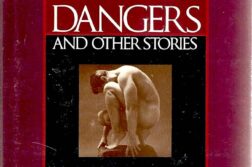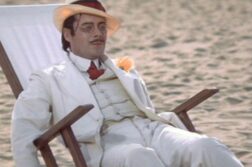AT A TIME in the 1970s when talk at the playground was of the sex scene on page 36 of The Godfather, I was perpetually reading page 47 of The City and the Pillar . Of course, I read Mario Puzo’s wet, sticky rendering of a prenuptial encounter for comparison with the passage that had come to enthrall me. And while Vidal’s scene was vaguer, even flirting with euphemism (“lights glittered in circles behind his closed eyelids, their eyes [were]shut and seeing for the first time”), it was far more realistic to me, as it involved two young men.
For months, every day after school, I would sit in a worn leather chair in the small library of my parents’ house and reread the passages about Jim Willard and Bob Ford in a Book-of-the-Month-Club edition of the famous (infamous, to some) 1948 novel. While I knew what happened between the teenage characters on their camping trip, I also didn’t—and so I read and reread trying to learn how they arrived at the point of their encounter and what exactly happened. I wanted to be prepared for something as thrilling and life altering. As the protagonist, Jim Willard, realized at the moment of embrace with his friend, “This was his world and he was alive.”
A few years after I had first found and read the book, my senior-year high school English teacher gave us a writing assignment in which we had to assume the first-person identity of someone currently in the news, and reflect on that person’s most important role model. It was a way to combine the current nonfiction world with that of fiction, proving that both were equally real.
My teacher was a progressive, tolerant, straight man who didn’t wear neckties and sometimes rode his bicycle home after school with a group of students who lived in his neighborhood in Evanston, Illinois (for some of us, he was our Miss Jean Brodie). Friends and I even dropped by his home one weekday night, at 11 p.m., to chat with him, something I still wince about—and without betraying any annoyance, he came downstairs in his bathrobe and pajamas and talked. Little could shock him. I was in the teenage phase of reckless self-revelation, testing the tolerance boundaries of friends, all in the pursuit of love, at a time when it seemed most of my peers were finding it. As each of them hooked up with a girlfriend, they slunk away into their relationship, leaving behind those of us who were unattached.
Already, at a kind of “true confessions” session with friends one Saturday night around a rec-room pool table, I had admitted that I was “bisexual”—although both the “bi” and the “sexual” were untrue. But the point that I was attracted to fellow male classmates was made. In fact, I was distractedly in love with a handsome boy named Chris who was not in the circle of my immediate friends and who had mysteriously arrived in our hometown from Canada, just for senior year. On the first day of school, he had tapped me on my shoulder, choosing me as his workout partner, and I remember saying to myself, “This is the first person I will love.” After I made this confession about Chris, one of my more progressive friends said: “It’s about you and Chris—I knew it! He’s why you don’t spend as much time with us as you used to.”
I let his remark stand, for it was exhilarating to have my friends, cue sticks frozen in their hands, think that Chris and I were having a physical relationship. For that to seem true meant that I was on par with some of them who had longtime steady girlfriends. So, for my English teacher’s assignment, I took on the persona of Leonard Matlovich, a prominent gay activist of the time who had been a much-decorated Vietnam War veteran. The character I had Matlovich cite as the most influential in his life was Jim Willard in The City and the Pillar .
In my voice, Matlovich became a casual-talking guy for whom being gay was a natural state. Using him as my medium, I was able to talk about my love for Chris and how I schemed and planned and fantasized about having the kind of encounter that Vidal’s characters had experienced. I proselytized that being gay was nothing to be ashamed of. And I insisted that being a gay male did not lead inevitably to the alcoholic, suicidal, murderous despair at the end of the novel. Years later, though, Matlovich would die of AIDS. As he said in his final public speech in 1988, “if there is any one word that describes our community’s reaction to AIDS, that word is love, love, love.”
Vidal’s dark rendering of the fate of gay men—and of course the term “gay” was not in widespread use in 1948—is what the reading public expected. In another popular book of my teenage years, Everything You Always Wanted to Know about Sex But Were Afraid to Ask, published at the same time I had encountered Vidal’s novel, the description of gay life by David Reuben, M.D., was as judgmental as something out of the Inquisition. I remember reading in despair, from that same leather chair, his description of how gay men met and interacted almost exclusively in bowling alley restrooms. And I didn’t even like bowling!
Over time, the more I reread Vidal’s book, the more conspicuous became its flaws, which included the overly tragic, fatalistic demise in store for homosexuals. But Vidal had written the book, his third novel, when he was only 22, and the fact that he took on the subject matter when he did makes him a visionary. In his introduction to an amended 1995 version of the novel, he recalls an editor warning him in 1948: “You will never be forgiven for this book.” Many major newspapers, including The New York Times, refused to review it, and as late as 1975 a copy was confiscated at an airport for obscenity.
But the book quickly became a bestseller when it was first published. Vidal’s revised version features a happier ending but also includes, to my dismay, a greatly neutered, less baroque version of the events I had read on page 47 of my edition. (Plus, it’s now on a different page.) Even their positions were now indeterminate: in the original, “Bob [was]on his back and Jim across him,” but that line was removed in the new version. Had I read this less sensual, vertigo-inducing, star-filled version of Jim and Bob’s consummation as a teenager, I wonder if the book would have had the same effect. That “shuddering sigh” between Jim and Bob on page 47 articulated a kind of love of which I needed an example at that time. It was something, as my English teacher had made clear, that could be both fictional and real.
This Art Memo was first published in the September-October 2013





